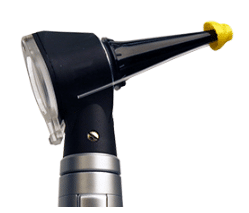
It’s never too late to learn!
Who would have thought that innovation is possible in a mundane thing like an ear impression otoblock?
As audiologists, we know how to take ear impressions – it’s part of our daily business. At least that’s what I thought when I started working in the Custom Products department at Phonak in 2013. After conducting several in-the-ear studies and research projects, and taking over 2000 ear impressions, I learned it is a more complicated procedure than I had once believed.
I had many questions — What makes an ear impression a good one? Do I have different requirements for the ear impression depending on the ITE style I want to order? How do I consistently take deep ear impressions in a comfortable way for the patient and myself?
The last question, in particular, interested me. The market has a demand for discreet and comfortable hearing aids, and to fulfill this demand, audiologists need to take high quality deep ear impressions.
So, why do audiologists feel insecure when it comes to taking deep ear impressions? Well, although the beginning of the ear canal wall is cartilaginous, for deep ear impressions, the otoblock needs to be placed in the bony part of the ear canal, which can easily lead to discomfort and pain for the patient.
The challenge is that the audiologist needs to insert the otoblock very deep in the patient’s ear without being able to see where the otoblock is going. With this in mind, our team ventured to provide a solution for audiologists in their daily work, by establishing a deep ear impression taking process.
We created an otoblock insertion method that requires a measurement of the ear canal length beforehand and an adjustment of the insertion depth of the otoblock insertion tool afterwards. The process worked perfectly, but in terms of usability, the audiological testers were not convinced. They asked for an insertion process that was quick and did not require additional tools – and they did not want to have to measure the ear canal length.
This feedback inspired our team to develop a product that would improve and simplify the insertion process further.
Step by step, we designed EasyView Otoblock, an adapter with a lens at the front, fitting on a standard otoscope. With the combination of the Lyric seal to the adapter and a vented tube we leveraged synergies with Lyric and used existing Phonak Technologies, that is proven to be safe and comfortable. All this made the product a great success. It typically takes only 3-5 ear impressions to get the hang of guiding the otoscope up to the ear drum during otoblock insertion.
In this short video, I discuss the benefits for HCPs and their patients.
We could see during our testing phase and when we introduced this product to internal audiologists before launch that all were convinced by the benefits. But, to be honest, we did not expect the great excitement about the product that we have seen in our order intakes. We are very pleased to see that EasyView Otoblock has met the needs of audiologists. We hope that this product will not only improve patient care, but also make the clinic room a comfortable place every time you take a deep ear impression.
If you want to learn more about the benefits of EasyView Otoblock have a look at our Field Study News.

